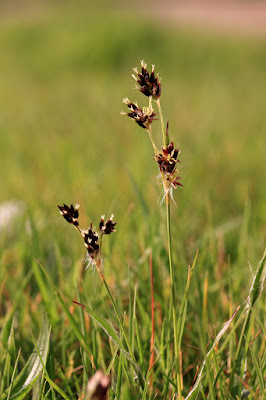I have heard that grass doesn’t grow when the soil
temperature is below 6 degrees C. It is
quite irritating then to find that despite the cold and dull weather that seems
to have persisted for weeks, that our lawn needs mowing. It’s even more irritating that it’s too cold
and wet to get out there for the first mow of spring. Grass is always a chore for gardeners, if
it’s in the border it needs weeding out, if it’s not it probably needs mowing.
 |
| Unidentified, possibly Sweet Vernal Grass |
It may however, be worth pausing as you empty the grass box,
to marvel at one of nature’s most successful plants. It grows just about everywhere from the high
tide mark to well above the treeline and from the tropical rain forests to all
but the driest deserts. It comes in many
forms – as grasses, sedges, and rushes, and even bamboo. Incidentally, grasses, sedges and rushes are
in separate families – Poaceae, Cyperacae, and Juncaceae respectively – and if
you are not sure which is which then you need to remember the rhyme, ‘sedges
have edges, rushes are round and grass stems are hollow right up from the
ground’. (That refers to the flowering
stems which are triangular in the case of sedges.) If you choose a grass species with fat seeds
and fill a field with it, then you will have part of the world’s staple
diet. Where would we be without wheat or
rice, or my own particular favourite, barley? (roasted and suitably mixed with
another favourite native plant species Humulus
lupulus, better known as the common
hop.) Another large part of our diet
(too large in many cases) is derived from yet another grass – sugar cane.
 |
| Canary Grass |
There are more than 10,000 different species of grass
worldwide, and it is likely that your garden, however tidy you keep it, will
contain a dozen or more different ones.
Identification of grasses is not easy and requires a lot of time looking
for identifying features and following keys.
The botanical language used is different to that used for other plants
because grasses have things like awns and stipules and spikelets that other
plants don’t have. Of course, the first
thing you need to do to identify any type of grass is to stop mowing it and let
it flower. Grasses are wind pollinated
and so they don’t need showy scented flowers to attract insects. This means that the flower features are quite
small and a hand lens is useful to see them clearly. I have managed to identify a few species in
our garden – Sweet vernal grass, which gives new mown hay its sweet smell,
Quaking grass, Cock’s Foot, Field Wood-rush (a small but pretty species), Perennial
Rye grass, and of course Common Couch grass.
Yet another species that I am trying to eradicate is Pendulous Sedge –
if you have any, I recommend that you don’t let it flower!
 |
| Unidentified, possibly one of the False Oats |
I find that the names of grasses have a sort of ancient and
romantic feel to them. Things like bents
and fescues, crested dog’s tail, wood melick and canary-grass. Believe it or not, there’s even one called
Timothy.
 |
| Field Wood-rush |
No comments:
Post a Comment